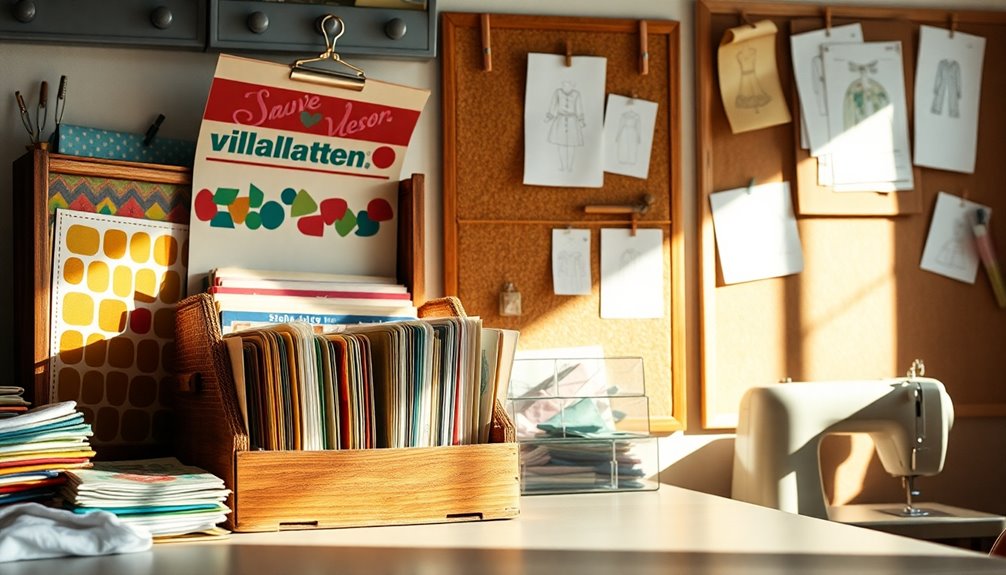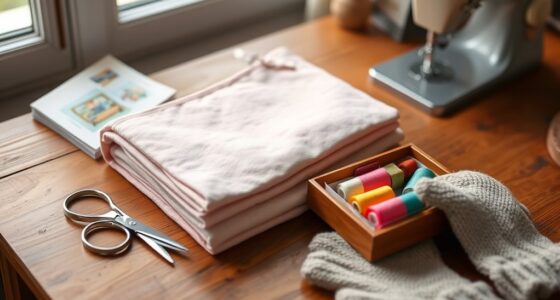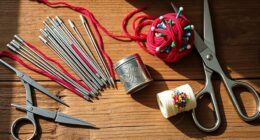To store sewing patterns effectively, try these seven creative ideas: roll patterns in cardboard tubes to prevent creases, use clear envelopes for visibility, or employ binders with plastic sleeves for protection. Consider hanging patterns on hooks for easy access or using Ziplock bags to protect against dust. Magazine holders can organize patterns upright too. Each method keeps your sewing area tidy and your patterns in great condition. Keep exploring to discover even more useful storage tips!
Key Takeaways
- Roll larger sewing patterns in labeled cardboard tubes to prevent creases and maximize storage space.
- Use clear plastic envelopes to protect patterns and keep them visible, organized in labeled storage boxes.
- Store patterns in three-ring binders with plastic sleeves for easy access and protection from wear and tear.
- Hang patterns on hooks or garment racks for vertical storage, promoting visibility and reducing clutter.
- Protect patterns in Ziplock bags to guard against dust and moisture, while using magazine holders for upright storage.
Rolled-Up Storage
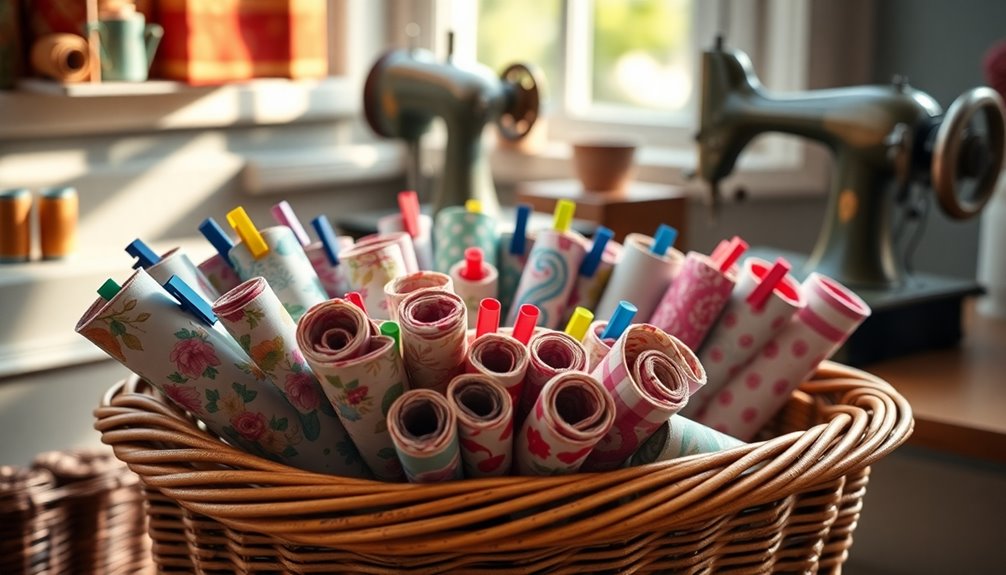
One effective way to store your sewing patterns is by rolling them up in cardboard tubes. This rolled-up storage method prevents creases and wrinkles, ensuring your paper patterns maintain their integrity for future use.
It's especially handy for larger patterns that don't fit well back into their original envelopes. By labeling the tubes, you can achieve quick identification, making it easier to find what you need without unrolling multiple tubes.
Storing the rolled tubes vertically not only maximizes space but also protects patterns from damage due to weight or compression. This technique keeps your sewing area organized, allowing for easy access and reference whenever you need to get creative with your projects.
Pattern Envelopes and Storage Boxes
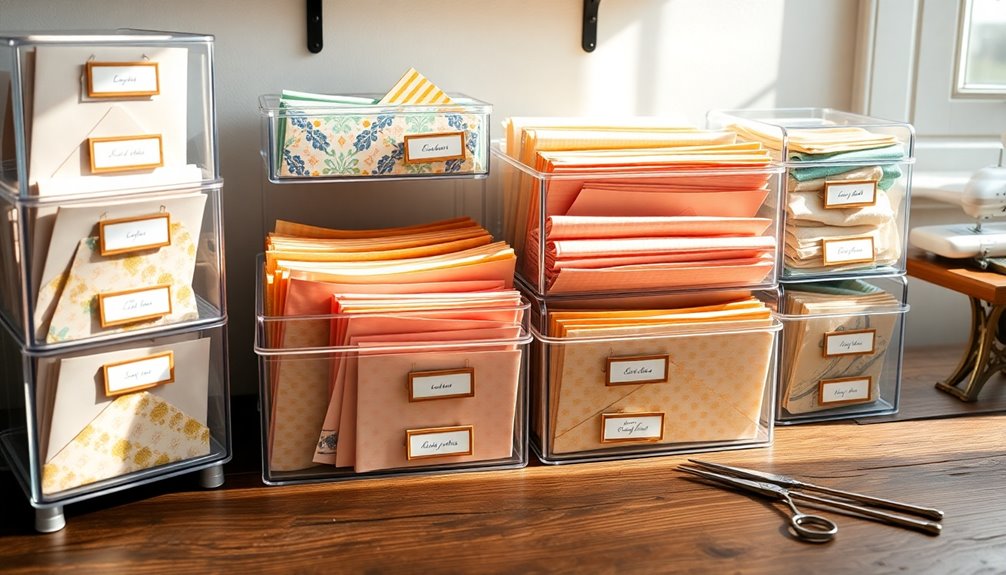
Storing your sewing patterns in clear plastic envelopes and labeled storage boxes can greatly enhance organization and accessibility.
These pattern envelopes provide visibility and protection against wear and tear, making it easy to identify each pattern at a glance. When you arrange these envelopes in labeled storage boxes, you can categorize your patterns by style, size, or project type for quick access.
To streamline the organization method, label each envelope with the company name, pattern number, and size. Using acid-free envelopes is wise, as they prevent damage from moisture and fading.
For added convenience, opt for flat storage to prevent creases, maintaining the integrity of your sewing patterns while keeping everything neat and tidy.
Binders and Plastic Sleeves

For those looking to take their sewing pattern organization a step further, binders paired with plastic sleeves offer a practical solution.
Using three-ring binders with plastic sleeves not only protects your sewing patterns from damage but also allows for easy flipping and browsing. By categorizing patterns into groups within the binder, you maintain organized storage and guarantee quick access during projects.
Sheet protectors keep each pattern visible while preventing creasing or tearing. Adding tab dividers enhances organization by separating patterns into specific categories, like clothing or accessories.
Finally, clearly labeling each binder makes it simple to identify its contents at a glance, streamlining the process of finding the right patterns when you need them.
Pattern Hooks and Hanging Solutions
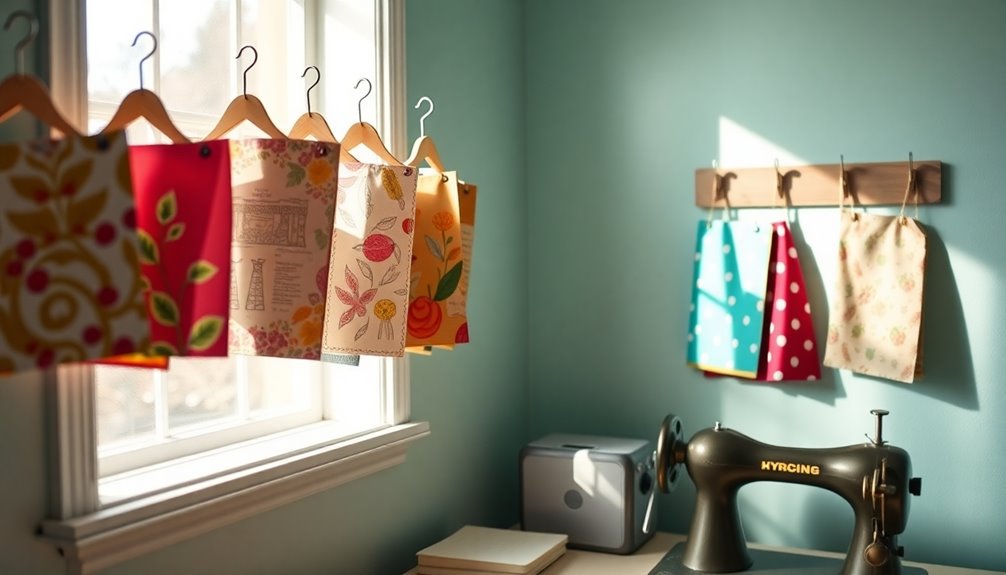
When you want to keep your sewing patterns accessible and organized, pattern hooks and hanging solutions are a game changer. By using pattern hooks, you can achieve vertical storage that prevents damage to your patterns while maximizing space in your sewing area.
These hooks come in various sizes, perfect for different types of patterns, from commercial tissue paper to larger designs. Hanging solutions like pant hangers, garment racks, or laundry bins allow for easy visibility, making it simple to browse patterns without the hassle of rummaging through stacks.
This efficient storage method enhances organization, so you can quickly find the perfect design for your next project. Say goodbye to clutter and hello to organized patterns!
Ziplock Bags and Magazine Holders

If you want a practical way to keep your sewing patterns safe and organized, using Ziplock bags and magazine holders is an excellent choice.
Ziplock bags protect your patterns from dust, moisture, and damage while offering clear visibility of the contents. Opt for gallon-sized bags for thicker patterns to prevent creases or tears.
By repurposing magazine holders, you can store your patterns upright, making it easy to flip through them for quick access. Both solutions promote organization through easy categorization, so you can swiftly locate specific styles or sizes.
Don't forget to enhance your setup with labeling—mark the Ziplock bags with pattern numbers and details to guarantee every pattern is identifiable and accessible when you need it.
Concertina Files and DIY Storage Solutions
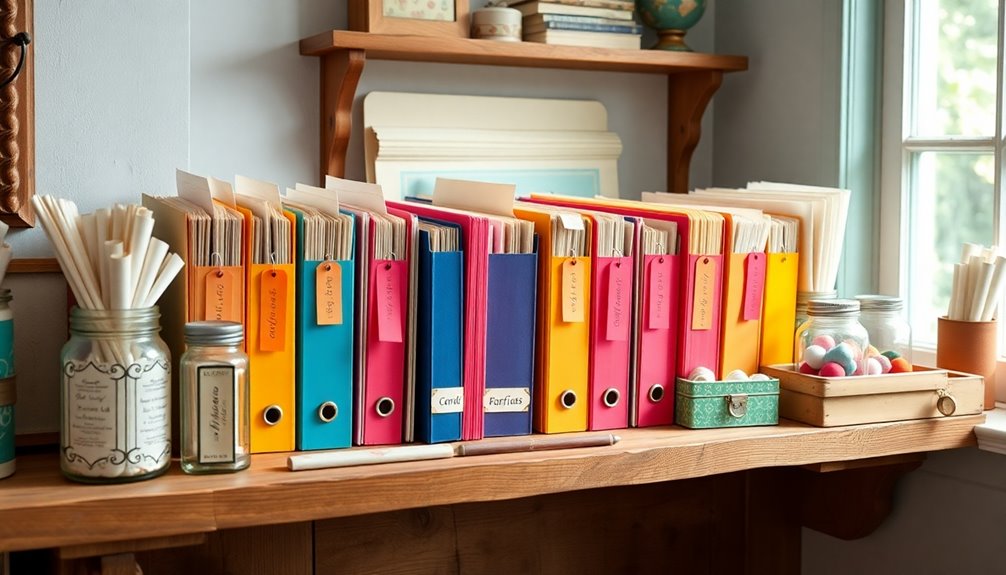
Concertina files are a fantastic way to keep your sewing patterns organized and easily accessible, thanks to their accordion-style design.
You can label each section to sort patterns by type or project, making your sewing space more efficient.
If you're feeling creative, consider crafting your own custom storage boxes to fit your unique needs and style.
Accordion-Style Folder Benefits
Using accordion-style folders for storing sewing patterns offers a practical solution that enhances organization and accessibility.
These folders, with their compact design, allow you to categorize your patterns by type, project, or size. This makes it easier to find specific patterns when you need them.
Their portability guarantees you can take patterns anywhere while protecting them from damage.
DIY storage solutions using concertina files are cost-effective and customizable, tailoring to your specific needs.
With clear pockets or labels, you gain visibility that helps streamline the process of selecting patterns during your sewing projects.
Customizable DIY Storage Boxes
When it comes to organizing your sewing patterns, customizable DIY storage boxes offer a versatile solution that suits your unique needs. You can create boxes tailored to various pattern sizes using durable materials like cardboard or decorative paper. This not only enhances durability but also adds a creative touch to your sewing space. Furthermore, incorporating labels will make it even easier to find specific patterns, streamlining your sewing projects. These DIY storage boxes can also double as inspiration boards, showcasing your favorite patterns while keeping them organized. This practice aligns perfectly with the custom fabric art creation process, allowing you to seamlessly blend practical organization with your artistic vision.
By labeling each box, you'll easily access and organize your patterns, ensuring an efficient system. Plus, these DIY storage boxes can be designed for easy transport, allowing you to take your projects to classes or sewing events.
Regularly maintaining and reorganizing your boxes helps you quickly locate the patterns you need, keeping your sewing journey enjoyable and stress-free.
Digital Pattern Organization
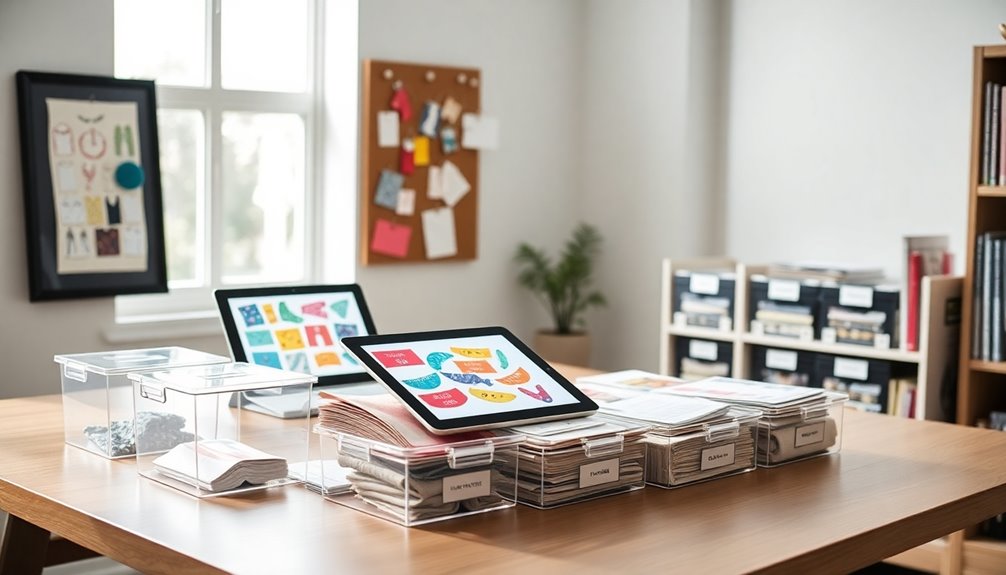
To keep your digital sewing patterns organized and easily accessible, consider utilizing cloud storage solutions that allow you to retrieve your files from any device.
Create organized folders based on categories like clothing, accessories, or costumes for efficient browsing. Regularly back up your digital patterns to external hard drives or USB flash drives to prevent data loss and guarantee security.
Use tagging software to enhance keyword searching, making it easier to find specific designs quickly. Additionally, maintain an updated inventory document that lists all digital patterns along with their corresponding folder locations.
This streamlined approach not only provides accessibility but also keeps your sewing journey efficient and enjoyable, allowing you to focus more on creativity and less on searching for patterns.
Frequently Asked Questions
How Do People Store Sewing Patterns?
People store sewing patterns in various ways to keep them organized and accessible.
You might use clear plastic envelopes or ziplock bags for easy visibility, or opt for binders with plastic sleeves to protect and categorize your patterns.
For larger pieces, rolling them in cardboard tubes can prevent creases.
Alternatively, hanging patterns on hooks or using accordion-style folders are great options that offer both protection and portability, making your crafting experience smoother.
How Do I Store My Patterns?
To store your patterns effectively, consider using clear plastic envelopes for visibility and protection.
You can categorize them by type or project in binders with plastic sleeves, making it easy to browse.
For larger patterns, rolling them in labeled cardboard tubes can prevent creases.
Ziplock bags work great for thicker patterns, and a filing cabinet or drawer system can help you organize your collection numerically or alphabetically for quick access.
How Do You Store Pattern Blocks?
Storing your pattern blocks is like organizing a treasure chest; you want to keep each gem safe and easy to find.
You can store them flat in acid-free sheet protectors to prevent creasing, or use sturdy binders with tabs for quick access.
For larger patterns, roll them around cardboard tubes to maintain their shape.
Don't forget to label everything clearly and keep an inventory list, so you'll always know what you've got on hand!
How Do You Preserve Sewing Patterns?
To preserve sewing patterns, you should store them in acid-free sleeves or envelopes, keeping moisture at bay.
Avoid direct sunlight to prevent fading, and maintain a dry environment with controlled humidity to fend off mold.
Handle your patterns gently, folding them carefully to prevent tears.
Consider scanning your patterns for digital backups, ensuring you have easy access without risking physical damage.
This way, your patterns will stay in great shape for years to come!
Conclusion
With these creative storage ideas, your sewing patterns can transform from chaotic paper piles into a well-organized treasure trove. Imagine reaching for a neatly rolled pattern like unearthing a scroll of inspiration, ready to ignite your next project. Whether you choose binders, boxes, or digital methods, the right storage will turn your sewing corner into a sanctuary of creativity. So, grab your favorite technique and watch your sewing journey flourish like a garden in full bloom!
